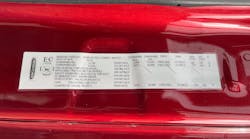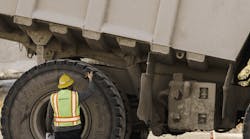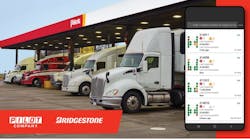Transporting some equipment the second week of June? Here's a heads-up: International Roadcheck is June 7-9, a 72-hour period when approximately 10,000 CVSA-certified local, state, provincial, territorial and federal inspectors in jurisdictions across North America perform large truck safety roadside inspections.
During the event, CVSA-certified inspectors conduct compliance, enforcement and educational initiatives targeted at various elements of vehicle and driver safety. Each year, International Roadcheck places special emphasis on a category of violations.
Special emphasis for 2016 International Roadcheck is tire safety, such as measuring the tire tread depth, checking the tire pressure, checking to make sure no items are lodged between dual tires, and examining the overall condition of the tire to ensure no deep cuts or bulges exist in the sidewalls of the tire.
Tires must have at least the minimum required tread depth measured in a major tread groove: 4/32 inch for front axle tires and 2/32 inch for all other tires.
Here is a list of top tire violations for which inspectors can ding you:
- Flat and/or Audible Air Leak
- Flat Tire or Fabric Exposed
- Other Tread Depth Less Than 2/32 -Inch
- Ply or Belt Material Exposed
- Load Weight Rating/Under Inflated 8
- Tread and/or Sidewall Separation
- Tires (General)
- Front Tread Depth Less Than 4/32-Inch
- Cut Exposing Ply and/or Belt Material
- Under Inflated Tire
- Weight Carried Exceeds Tire Load Limit
- Tire Under ‐ Inflated
Best Practices for Tire Maintenance and Management
Inflation - know what your tire manufacturer recommends and then check with your dealer. Over-or-under inflation is the primary cause of tire failure but because your fleet probably doesn't operate the same way and over-the-road fleet does, it can't hurt to get the opinion of an expert who understands the demands of haul equipment. Tires are engineered for use in a certain pressure range but real life use needs to be considered in your maintenance program.
If you have an automatic tire inflation system (ATIS) on your vehicle, check that it works, is calibrated correctly, and you are tracking any issues your monitoring might show.
Check the wheel's flange. Make sure it's clean with no grit, dirt or other abrasives that can get trapped near the bead seat of the tire and cut into the sidewall of the tire.
How are your valves? Just checking.
If the tire tread still meets requirements, make sure that tread patterns and depths are similar. For example, significant differences in outside tires can cause uneven wear or an overloading situation on one tire and wheel assembly.
If you are running retread tires, be especially vigilant monitoring wear. There really is no rule of thumb on how long the casing will perform - your fleet is unique and affected by what you haul, the road or off-road conditions you encounter, and your driver's skills.
Make sure your truck's suspension is aligned properly. Poor alignment wears tires and makes the vehicle harder to control. Several alignment factors must be considered to achieve proper wheel alignment. The top four factors are: toe, tracking, camber and caster. Toe affects front end skimmy which makes the front wheels fight each other and wear quickly. Tracking alignment is gauged relative to the vehicle's center line and affects the outside wear of the steer tires. Camber is the inward or outward tilt of the wheel and what keeps the tire flat on the road. Caster is the forward or rearward tilt of the kingpin and leads to driver fatigue.
Trailers with dual tires mounted to a conjoined wheel assembly need to be mated carefully. Make sure both tires have similar tread patterns and designs, and the same diameters. Tires with as little as 1/2-inch difference may seem close enough, but experts say that over time the larger tire will bear the extra weight while the smaller tire gets dragged along up to 5.2-feet per mile.
Inspections are a hassle but they can motivate fleets to take a close look at the health of their fleet's tires.
Another FYI: As long as they've got your truck stopped, here are the other things they will be looking at:
The 37-step inspection includes checking the vehicle's braking system, coupling devices, exhaust system, frame, fuel system, lights, steering mechanism, driveline/driveshaft, suspension, tires, trailer bodies, wheels and rims, windshield wipers. How construction equipment is secured to the vehicle is also checked.
Drivers will need to have their license, endorsements, medical card and hours-of-service documentation, and may be checked for seat belt usage and the use of alcohol and/or drugs.
For a slide show featuring tips to get through an inspection quickly, click on Fleetowner.com here.





